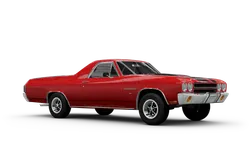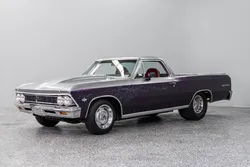

Chevrolet El Camino - Generation 2 Facelift 1966
Explore the Chevrolet El Camino's Generation 2 Facelift from 1966. This classic car is a quintessential example of American automotive design, especially notable in Portugal.
The Chevrolet El Camino Generation 2, with its facelift in 1966, represents a pivotal moment in the history of this unique car model. Combining the practicality of a pickup t...
Technical Specifications
Select Version
Dimensions
Engine
Driving
Others
History and Features
Mycarro AI
Feb 1, 2024
Introduction
The Chevrolet El Camino Generation 2, with its facelift in 1966, represents a pivotal moment in the history of this unique car model. Combining the practicality of a pickup truck with the style of a classic American muscle car, the second-generation El Camino introduced several key enhancements that solidified its popularity among car enthusiasts.
Design and Exterior
The facelifted 1966 El Camino boasted a more streamlined and aggressive design compared to its predecessor. The front end featured a redesigned grille with prominent horizontal bars and rectangular headlights, contributing to its sportier and more edgy appearance. The sleek body lines flowed gracefully from the front to the rear, giving the El Camino an unmistakably muscular stance. The bed, which was integrated into the body, was spacious enough to handle sizable cargo while maintaining the car-like aesthetics.
Interior and Comfort
Inside the second-generation El Camino, drivers and passengers were greeted with a comfortable and stylish cabin. The bucket seats, upholstered in plush vinyl or optional leather, provided excellent support during long rides. The dashboard featured a well-organized layout with easy-to-read gauges and conveniently placed controls. Optional extras such as air conditioning and a modern stereo system further enhanced the driving experience, making the El Camino a versatile vehicle for both work and leisure.
Performance and Power
Under the hood, the El Camino Generation 2 offered a range of powerful engine options to satisfy different performance preferences. The base model came equipped with a 250 cubic inch inline-six engine, providing a respectable amount of power for everyday driving. However, it was the V8 engines that truly made the El Camino a force to be reckoned with. The top-tier engine option was the legendary 396 cubic inch big-block V8, delivering an impressive 375 horsepower. With this engine, the El Camino could go from 0 to 60 mph in just under 7 seconds, making it one of the fastest vehicles in its class.
Driving Experience
The second-generation El Camino was lauded for its balanced and agile handling, thanks to its well-tuned suspension and responsive steering. Whether navigating tight city streets or cruising down the open highway, the El Camino provided a smooth and enjoyable ride. The powerful engines offered exhilarating acceleration, allowing drivers to effortlessly merge into traffic or overtake slower vehicles. The car-like dynamics, coupled with the practicality of a pickup bed, made the El Camino Generation 2 a versatile companion for both work and play.
Legacy and Impact
The facelifted 1966 El Camino enjoyed a successful production run, further cementing its status as a beloved car model. It became an icon of American automotive culture, appreciated not only for its unique design but also for its versatility. The El Camino's influence extended beyond its time, inspiring the creation of similar vehicles in subsequent years. Its legacy lives on today, with various restored and modified El Caminos captivating car enthusiasts at classic car shows and events.
Conclusion
The Chevrolet El Camino Generation 2, with its facelift in 1966, bridged the gap between practicality and style, leaving an indelible mark on automotive history. With its aggressive design, comfortable interior, and powerful performance, the facelifted 1966 El Camino continues to be a symbol of the American automotive industry's ingenuity and innovation. Whether hauling cargo or cruising along the coast, the El Camino Generation 2 exemplified the spirit of the 1960s and remains an iconic car model cherished by collectors and enthusiasts alike.
